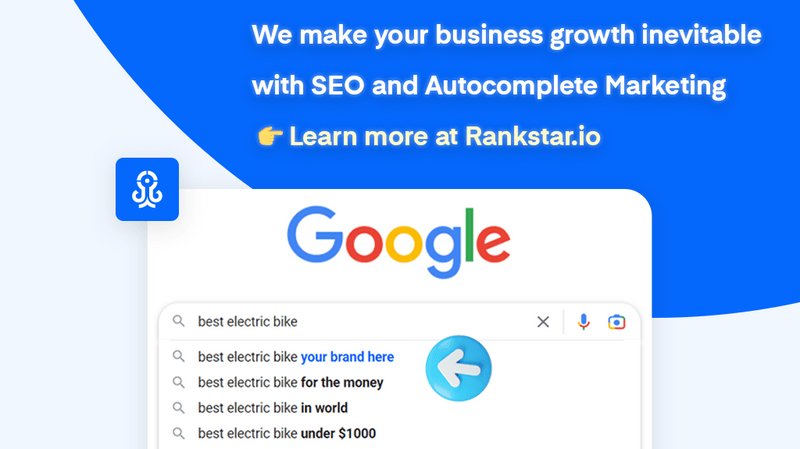You’re ready to take your website to the next level, aren’t you?
Optimizing web design for higher search rankings isn’t just smart, it’s necessary. By incorporating strategic keywords, boosting site performance, and using meta tags effectively, you’ll see your site ascend in search engine rankings.
Get ready to delve into the transformative world of SEO web design – your journey to increased visibility and traffic starts here.
Contact Rankstar to Get Support for Your SEO Web Design
Transform or Create Your Site with SEO Web Design – Want higher search rankings and more organic traffic? Rankstar provides SEO website design and development to maximize visibility.
Our web design process optimizes site architecture, usability, and technical elements for better rankings. We integrate keyword optimization and site speed best practices into modern, responsive websites.
Don’t settle for just any web design. Contact Rankstar for SEO website development focused on driving conversions from the search results.
Claim the rankings you deserve with expert web design optimized for search engine success.
Contact us to discuss your project.

Understanding the Concept of SEO Web Design
You’ve got to grasp the concept of SEO web design. It’s a strategy that merges website design with search engine optimization to boost your site’s visibility on search engine result pages.
Think of it as a two-way street. You’re not only designing a site that’s visually appealing but also one that’s a hit with search engines. By incorporating keywords strategically, you’re telling search engines what your site is about.
Speed is another key factor. Optimize your website’s performance to ensure users don’t bounce off due to slow load times.
Don’t forget meta tags and descriptions; they’re your site’s first impression on search engine results. Effective utilization of these elements can lead to higher click-through rates.
The Advantages of On-page SEO Web Design
When you implement SEO best practices in your website’s layout, it’s not just about improving its visibility on SERPs, but also about enhancing the overall user experience. SEO web design is a win-win strategy: it’s user-friendly and search engine-friendly. Here’s how it benefits you:
- Higher Search Rankings: Strategic keyword use skyrockets your website to the top of search results, driving more organic traffic your way.
- Improved User Experience: Faster loading times, easy navigation, and engaging content keep users on your site longer.
- Cost-Effective Marketing: With increased visibility, you’re pulling in high-intent traffic without the hefty advertising costs.
- Enhanced Brand Credibility: A well-optimized, professional-looking site builds trust, elevating your brand’s reputation.
The Impact of Ranking Positions on Organic Traffic
It’s crucial to understand that your site’s position on SERPs significantly affects the amount of organic traffic you receive. If you’re not in the top results, you’re missing out. The first search result snags a whopping quarter of all clicks. Slide down to the second spot, and you’re looking at about 15 percent.
That’s why it’s essential to strategically incorporate keywords into your content and optimize your website speed. Fast page loads keep visitors engaged, reducing bounce rates. Equally important is using meta tags and descriptions effectively. They not only help search engines understand your content but also entice users to click on your link.
Essential Techniques in SEO Web Design
Let’s delve into some crucial techniques in SEO that can significantly enhance your site’s visibility and organic traffic.
Now, it’s all about strategic keyword incorporation, site speed optimization, and effective use of meta tags and descriptions.
- Strategic Keyword Incorporation:
- You’ve got to understand your audience’s search intent.
- Then, you’ll sprinkle those keywords naturally throughout your content.
- Site Speed Optimization:
- You’ll need to ensure your site loads quickly.
- This might involve compressing your images or reducing server response time.
- Effective Use of Meta Tags and Descriptions:
- Remember, meta descriptions can influence click-through rates.
- Craft them carefully, incorporating your keywords.
Master these techniques, and you’ll be on your way to a website that’s not just beautiful, but SEO-friendly too.
Unlocking The Power Of Topic Clusters For Seo Success While Developing your Site
In an ever-evolving digital landscape, the importance of strategic search engine optimization (SEO) in enhancing organic traffic and online visibility cannot be understated.
A significant advancement in SEO strategy is the development and implementation of topic clusters. This approach, which includes pillar content and cluster content, offers a comprehensive exploration of industry-specific material, thereby increasing keyword rankings.
This article will delve into the intricacies of topic clusters, elucidating their role in SEO success. The discussion will encompass the implementation of a cluster strategy, focusing on keyword research and internal linking hierarchies.
Additionally, potential pitfalls such as keyword cannibalization and strategies to avoid them will be analyzed. The ultimate objective is to unlock the power of topic clusters, thereby establishing websites as industry authorities, and consequently, enhancing their SEO success.
Understanding Topic Clusters
Understanding Topic Clusters involves recognizing their role as a potent SEO strategy that consists of a group of content assets focused on a related topic, designed to demonstrate industry expertise, enhance keyword rankings, and boost organic traffic.
These clusters are composed of a central pillar content that targets general industry keywords and numerous cluster contents that focus on subtopics or common questions. This approach aids in ranking for less competitive keywords, building credibility, and assisting Google in comprehending the hierarchy and interrelation of website content.
The pillar and cluster contents are interconnected via internal links, forming a linking hierarchy that emphasizes the importance of the pillar content. The effective implementation of this method can drastically improve the structure of a website.
Implementing a Cluster Strategy to SEO Web Development
Implementing a cluster strategy requires strategic planning and organization to effectively establish relevance and boost search engine rankings. The process entails a systematic approach to ensure content is well interconnected and adequately optimized for search engine visibility.
- Start by identifying the pillar content, which should revolve around key industry topics or high-volume keywords.
- Conduct extensive keyword research to generate ideas for the cluster content. Tools such as Google Autocomplete or keyword research platforms can be useful.
- Ensure each piece of cluster content targets a specific subtopic or common question related to the pillar topic.
- Implement internal linking strategies to connect the pillar content with the related cluster content, emphasizing their interrelation.
- Regularly review and update the content to maintain its relevance and accuracy, maintaining its position in search engine rankings.
Avoiding Keyword Cannibalization During SEO Design.
Addressing the issue of keyword cannibalization is essential when curating content for a cluster strategy, as it prevents internal competition and optimizes the effectiveness of each piece of content. This issue arises when similar content targets the same keywords, leading to competition for ranking between them. It dilutes the SEO value and can harm the overall website ranking.
To avoid this, it is recommended to regularly review the content and ensure each piece targets unique keywords. Below is a brief guide to help in this process:
| Steps | Description |
|---|---|
| Content Audit | Identify pieces of content that target similar keywords |
| Review Titles/H1s | Ensure they are unique and accurately represent the content |
| Check Internal Links | Make sure they point to the relevant pillar page |
| Build Links | Focus on directing external links to pillar pages, not cluster content |
The Role of Sitemaps in SEO Web Development
You’ll find sitemaps to be integral in SEO, as they provide a roadmap of your site for search engines, improving visibility and organic traffic. They’re like your site’s blueprint, guiding search engines to all your important pages.
Sitemaps also help in optimizing website speed and performance, as search engines can crawl and index your site more efficiently. It’s crucial to update your sitemap regularly, especially when you add new pages or content.
Don’t forget to use meta tags and descriptions effectively in your sitemap. They’re not just for show; they give search engines a brief overview of what each page is about. So, make sure they’re engaging and contain your focus keywords.
Importance of Readability and Image Optimization in SEO Web Design
Moving on from the role of sitemaps, let’s delve into the importance of readability and image optimization in SEO web design. You see, it’s not just about making your site look good, it’s also about making sure it’s easy to read and navigate.
Here are three key points to consider:
- Readability: Keep your content clear, concise, and easy to digest. Break up text into manageable chunks, use bullet points and subheadings, and choose fonts that are easy on the eye.
- Image Optimization: Images can slow down your site if they’re not optimized properly. Keep file sizes small, use descriptive file names, and don’t forget to include alt tags with relevant keywords.
- Meta Tags and Descriptions: These are vital for SEO. Make sure each page has a unique title and description that includes your focus keywords.
Incorporating these strategies helps optimize your website’s speed, performance, and, most importantly, its visibility in search results.
How to Optimize Website Navigation and URL Structure
In creating a user-friendly site, it’s critical to focus on the navigation and URL structure. Intuitive navigation guides your users, increasing their engagement and reducing bounce rates. Make your site’s structure simple, and incorporate internal links to boost SEO. Strategically use keywords in your URL structure for better visibility.
Speed is the essence of a great user experience. Optimize your website’s performance with compressed images, minimized CSS and JavaScript, and reliable hosting.
Don’t forget about meta tags and descriptions. They’re not just for SEO; they’re your first interaction with potential visitors on search engines. Make them compelling and keyword-rich.
Understanding Metadata and Its Impact on Search Rankings
Understanding metadata and its impact on your site’s visibility is crucial, as it’s one of the key factors that search engines consider when ranking pages. Metadata, including title tags and meta descriptions, should be effectively optimized with strategic keywords to increase your site’s visibility and performance.
- Title tags: The title of your page, reflected in search results. Make it descriptive and concise. Include your focus keyword.
- Meta descriptions: Brief summaries of your page that appear under the title in search results. Write it to entice users to click. Use your focus keyword strategically.
The Importance of Indexable Content in SEO Web Design
You’ve got to ensure your site’s content is indexable if you’re aiming for a significant impact on SEO. Remember, search engines need to read your content to rank it. Imagine your site as a book; the more accessible and readable it is, the more likely it’s going to be recommended.
Incorporate your keywords strategically, not haphazardly, ensuring they flow naturally within your content. Prioritize optimizing your website’s speed and performance, as slow-loading pages can deter visitors and hurt your rankings.
Equally important are your meta tags and descriptions. They provide succinct information about your page to search engines. Optimize them effectively by including relevant keywords.
In essence, creating indexable content is a crucial part of SEO web design.
The Need for Collaboration and Regular Monitoring in SEO Web Design
Collaborating with your development team and regularly monitoring your site’s performance are essential steps for a successful SEO strategy. You’re not just building a site, you’re constructing a well-oiled machine. This requires a hands-on approach, constant tweaking, and a keen eye for detail.
Consider the following steps:
- Strategic keyword incorporation: Infuse your content with keywords, but do it strategically, avoiding keyword stuffing.
- Optimize site speed: Your site’s loading time can affect your SEO rankings. Make sure it’s up to snuff.
- Effective meta tags and descriptions: These little details can make a big impact on your SEO performance.
- Regular monitoring: Keep an eye on your site’s performance. Use tools like Google Analytics to track your progress.
- Team collaboration: Work closely with your development team for a synergistic approach to SEO optimization.
Frequently Asked Questions
What Are Some Common Mistakes to Avoid in SEO Web Design?
You shouldn’t stuff keywords, ignore website speed, or neglect meta tags and descriptions. Avoid complex navigation, irrelevant content, content overlapping, and failing to make your website mobile-friendly. Always prioritize user experience (UX), and accessibility in your design.
How Does Mobile Optimization Factor Into SEO Web Design?
In SEO web design, mobile optimization’s crucial. You’re enhancing user experience on mobile devices, improving site speed, and incorporating strategic keywords. It’s about using meta tags effectively, ultimately boosting your site’s search engine rankings.
How Can Social Media Integration Contribute to SEO Web Design?
By integrating social media into your web design, you’re increasing engagement and sharing, which can boost your site’s SEO. It’s about creating a seamless user experience that encourages social interaction, ultimately improving search rankings.
What Is the Role of Website Speed in SEO and How Can It Be Optimized?
Website speed plays a pivotal role in SEO. It affects user experience and bounce rates. You can optimize it by minimizing HTTP requests, enabling compression, reducing server response time, and optimizing images and CSS delivery.
Are There Any Specific SEO Web Design Strategies for E-Commerce Websites?
Yes, for e-commerce SEO web design, you’ll prioritize mobile-friendly design, integrate easy navigation, use descriptive alt tags for product images, and optimize product descriptions with strategic keywords to improve your site’s search rankings.
Conclusion
In conclusion, SEO web design is vital for boosting your site’s visibility and generating organic traffic. By strategically incorporating keywords, optimizing performance, and effectively using metadata, you elevate your website’s search ranking.
Regular collaboration and monitoring are key to your success. So, take the leap and make SEO web design a priority – it’s a cost-effective strategy that delivers real results.



















